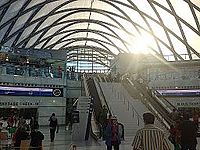
The Orange County Transportation Authority (OCTA) is the transportation planning commission for Orange County, California in the Los Angeles metropolitan area. OCTA is responsible for funding and implementing transit and capital projects for the transportation system in the county, including freeway expansions, express lane management, bus and rail transit operation, and commuter rail funding and oversight.

The Pacific Surfliner is a 350-mile (560 km) passenger train service serving the communities on the coast of Southern California between San Diego and San Luis Obispo.
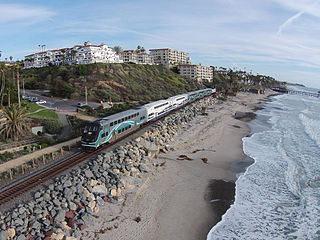
Metrolink is a commuter rail system in Southern California, serving Los Angeles, Orange, Riverside, San Bernardino, and Ventura counties, as well as to Oceanside in San Diego County. The system consists of eight lines and 69 stations operating on 545.6 miles (878.1 km) of track. Arrow is operated under a contract with the San Bernardino County Transportation Authority (SBCTA).
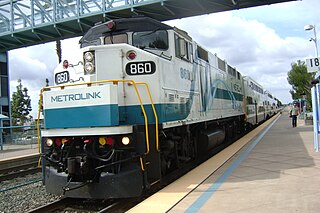
The Orange County Line is a commuter rail line run by Metrolink from Los Angeles through Orange County to Oceanside in San Diego County, connecting with the Coaster commuter rail service to San Diego. The Orange County Line carries passengers to the primary Metrolink hub at L.A. Union Station in downtown Los Angeles, as well as to many attractions in Orange County including the Knott's Berry Farm area, Angel Stadium of Anaheim and the Honda Center, the Disneyland Resort, Old Town Orange, Santa Ana Zoo, Mission San Juan Capistrano and many more. In San Diego County, it serves the Oceanside Pier and Camp Pendelton.
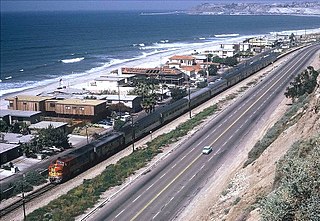
The Surf Line is a railroad line that runs from San Diego north to Orange County along California's Pacific Coast. It was so named because much of the line is near the Pacific Ocean, within less than 100 feet (30 m) in some places. The tracks are now owned by the Orange County Transportation Authority and the North County Transit District, and hosts Metrolink's Orange County Line and Inland Empire–Orange County Line, the San Diego Coaster, and Amtrak Pacific Surfliner passenger trains. The BNSF Railway operates freight over the line using trackage rights.

Burbank Airport–South station, referred to as Hollywood Burbank Airport station by Amtrak and formerly known as Bob Hope Airport station, is an unstaffed Amtrak and Metrolink train station on the southeast corner of Hollywood Burbank Airport in the city of Burbank, California. Amtrak's Pacific Surfliner from San Luis Obispo to San Diego, Amtrak's Coast Starlight from Los Angeles to Seattle, Washington, and Metrolink's Ventura County Line from Los Angeles Union Station to East Ventura stop here.

The Platinum Triangle is a district of Anaheim, California, United States, that is undergoing transformation from a low-density commercial and industrial zone into a more urban environment with high-density housing, commercial office towers, and retail space. The 820 acres (330 ha) area undergoing this large-scale redevelopment includes the city's two major sports venues, the Honda Center and Angel Stadium of Anaheim.

Chatsworth station is an intermodal passenger transport station in the Los Angeles neighborhood of Chatsworth, United States. It is served by Amtrak inter-city rail service, Metrolink commuter rail service, Los Angeles Metro Busway bus rapid transit, and several transit bus operators.

The Fullerton Transportation Center is a passenger rail and bus station located in Fullerton, California, United States.

The Santa Ana Regional Transportation Center is a passenger rail station and transportation center in Santa Ana, California. It is used by Amtrak's Pacific Surfliner and Metrolink's Orange County Line and Inland Empire–Orange County Line trains. It is also a Greyhound station and a hub for the Orange County Transportation Authority bus system as well as a terminal for international bus services to Mexico.

The Glendale Transportation Center is an Amtrak and Metrolink train station in the city of Glendale, California. It is served by the Amtrak Pacific Surfliner intercity rail route and the Metrolink Ventura County Line and Antelope Valley Line commuter rail routes.
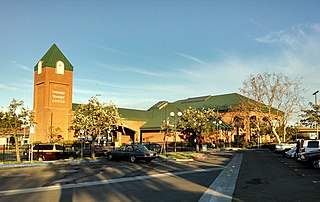
The Oxnard Transit Center is an intermodal transit center in downtown Oxnard, California. It is served by Amtrak Coast Starlight and Pacific Surfliner intercity service plus Metrolink Ventura County Line commuter service.

The Irvine Transportation Center is a passenger rail and bus terminal in the Irvine Spectrum district of southeastern Irvine, California, United States. Located on the southwest end of the decommissioned Marine Corps Air Station El Toro, it is served by Amtrak California's Pacific Surfliner route, two Metrolink commuter rail lines, and multiple Orange County Transportation Authority bus routes.
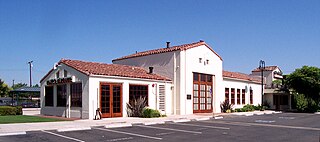
Orange station, formally the Orange Transportation Center, is an intermodal transit station in Orange, California. It serves Metrolink trains as well as Orange County Transportation Authority buses. The station is located at the site of two former Atchison, Topeka and Santa Fe Railway combination depots. The present depot structure was dedicated on May 1, 1938, and was closed with the Santa Fe's discontinuation of passenger service in 1971. The building was granted historic landmark status by the City on November 15, 1990.

Buena Park station is a train station in Buena Park, California, United States, served by Metrolink commuter rail. It is at the center of a transit-oriented development including townhomes and a housing complex owned by the California State University, Fullerton, near the corner of Dale Street and Malvern Avenue. The station is served by Metrolink's Orange County Line and 91/Perris Valley Line.

Laguna Niguel/Mission Viejo is a station on the Inland Empire–Orange County Line and Orange County Line of the Metrolink commuter rail system around Southern California. Originally built to serve Metrolink, the station became a stop for Amtrak's Pacific Surfliner in 2007 but is currently not used as a limited Amtrak stop on the Pacific Surfliner route. Total daily ridership for Metrolink and Amtrak was about 500 passengers in fiscal year 2009. Of the 73 California stations served by Amtrak, Laguna Niguel/Mission Viejo was the 71st-busiest in FY2010, boarding or detraining an average of approximately seven passengers daily. Metrolink trains terminate here and if they do by noon time, one train set moves over to a nearby siding track until the rush hour.

The West Santa Ana Branch is a rail right-of-way formerly used by the Pacific Electric's (PE) Santa Ana route in Los Angeles County and Orange County in Southern California. The Los Angeles County Metropolitan Transportation Authority (Metro) owns the segment of the right-of-way in Los Angeles County, and the Orange County Transportation Authority (OCTA) owns the segment in Orange County.
The OC Streetcar is a modern streetcar line currently under construction in Orange County, California, running through the cities of Santa Ana and Garden Grove. The electric-powered streetcar will be operated by the Orange County Transportation Authority (OCTA), and will serve ten stops in each direction along its 4.15-mile (6.68 km) route. With the exception of a short loop in downtown Santa Ana, the line will be double-tracked for its entire length. Most of the route follows the original path of the Pacific Electric Railway "Red Cars" that served Santa Ana in the early 20th century, before being abandoned in 1950. Construction on the streetcar broke ground on November 30, 2018. As of October 2023, the line's expected revenue service date has been pushed to August 2025, per OCTA staff, despite initial plans for a 2021 start.

Anaheim Rapid Connection (ARC) was a proposed streetcar line in Anaheim, California. It would have been located in the Anaheim Resort and Platinum Triangle, with stops at the Disneyland Resort, the Anaheim Convention Center, and the Anaheim Regional Transportation Intermodal Center (ARTIC), among others. It has been the subject of much political controversy, which led to the project being cancelled by OCTA in 2018. Councilmembers from the cities of Anaheim and Fullerton stated opposition to the streetcar mode citing concerns about traffic impacts, safety, capital costs, and recent declining transit ridership. These cities also shared concerns about how implementation of dedicated transit lanes would impact automobile traffic.





